

Making a change is never easy – but if you take it step-by-step you can make it work.

This infographic by G2G3 illustrates the different stages of managing organizational change the right way. For example, the first phase in the model is called “Discover”. In the first layer, the employees are dealing with the first shock and that’s why, on the way to the bridge, the person who’s leading the charge should involve them and ask for their feedback. In the bottom layers – the surveys, plan and readiness consulting should help you decide how ready the organization is for the upcoming change and what exactly your targets are. Identifier ces croyances qui bloquent tout changement. Pour changer la culture de l’organisation, agir sur les croyances des collaborateurs est indispensable.

Cela commence par un diagnostic culturel ! Agir sur les croyances de l’organisation est la clé du changement. La performance d’une entreprise réside dans sa capacité à s’adapter aux besoins changeants de ses clients et de ses collaborateurs… ce qui nécessite de savoir faire évoluer sa culture. Mais attention, aucun changement n’est possible sans un diagnostic culturel précis. Sans diagnostic préalable, impossible en effet de faire bouger une culture organisationnelle empêtrée dans ses propres résistances.
Valeur affichée : collaborer. L’agilité culturelle, clé de la compétitivité Une culture forte, mais déconnectée de l’environnement ne peut être source de performance ; seul l’alignement de la culture avec un contexte crée de la valeur. GRdF: un changement en cours Se transformer suite à la dérégulation de son marché, tel fut le pari de GRdF en 2007. Nine Reasons Organizations Need To Change by Robert W. Swaim. Contributor: Robert W.
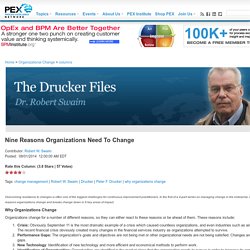
Swaim Posted: 08/01/2014 12:00:00 AM EDT Rate this Column: (3.8 Stars | 57 Votes) Tags: change management | Robert W. Swaim | Drucker | Peter F. Kotter's 8 step change model. Lewin, Stage Model of Change Unfreezing Changing Refreezing AnimatedPart 5. Amazing infographic: Understanding the Different Layers of Change Management - Change!
Process Improvement. Accueil - BRIO. Sans titre. By becoming more data-driven, adding more analytical talent and capabilities to your team, and refining your analytical and process skills, you are creating an opportunity to generate greater business-relevant insights.
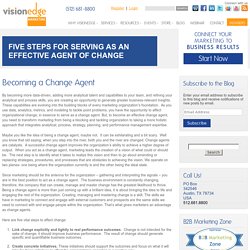
These capabilities are evolving into the building blocks of every marketing organization’s foundation. As you use data, analytics, metrics, and modeling to tackle point problems, you have the opportunity to affect organizational change, in essence to serve as a change agent. But, to become an effective change agent, you need to transform marketing from being a blocking and tackling organization to taking a more holistic approach that integrates analytical, process, strategy, planning, and performance management expertise.
Maybe you like the idea of being a change agent, maybe not. Change: What Has The Brain Got To Do With It? This week, Linda Ray, the co-founder and co-director of neuresource group, looks at how the brain responds to change and suggests a few ways leaders can utilise new research in neuroscience to implement effective change plans.
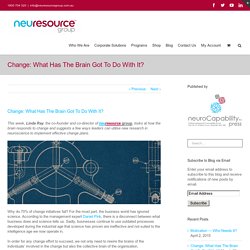
Why do 70% of change initiatives fail? For the most part, the business world has ignored science. According to the management expert Daniel Pink, there is a disconnect between what business does and science tells us. Sadly, businesses continue to use outdated processes developed during the industrial age that science has proven are ineffective and not suited to the intelligence age we now operate in. Free Change Management Downloads. Tools for Visualizing Complex Change.
A few years ago while attending PSL, myself and a group of people decided to tour around New Mexico.

Top 20+ change management mistakes to avoid. Driving and managing change will remain the number one priority for leaders according to a recently published study.

But the reality is that most change efforts fail. Many of these failures can be traced to these common change management mistakes: Mistake #1 – Starting too late Pressure to act quickly undermines values and culture. Leaders take drastic steps quickly with no time to explore alternatives. Mistake #2 – No winning strategy. » Five Effective Strategies to Tackle Change. Just as with any business decision that affects the bottom line, there are various reasons that a company will decide to employ a change management strategy. Every business, no matter the size or industry, faces both internal and external pressures that influence short-term and long-term strategies.
External pressures may include shifting economic conditions, governmental or regulatory fluctuations, cultural changes, or technological developments that render particular products and services obsolete. Internal pressures may include a new management team, the development of a product that disrupts the overall market, or the need to expand or downsize. In theory, the change may be the best thing to ever happen to a company, but if it lacks the support of those tasked with putting it in place, the idea becomes irrelevant.
Shift happens. 10 Ways to Shift Gears for Employee Engagement and Change Management. We don't have to engage in grand, heroic actions to participate in the process of change.

Small acts, when multiplied by millions of people, can transform the world. ~ Howard Zinn. Who's model would you say is better Lewin's or Kotter's. Applying Kotter's change management model. I have previously outlined the importance of change managers having a clear idea of the theory that underpins their change methodology.
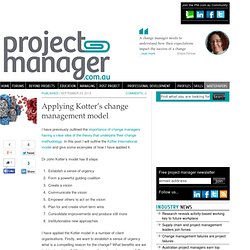
In this post I will outline the Kotter International model and give some examples of how I have applied it. Dr John Kotter’s model has 8 steps: Establish a sense of urgencyForm a powerful guiding coalitionCreate a visionCommunicate the visionEmpower others to act on the visionPlan for and create short-term winsConsolidate improvements and produce still moreInstitutionalise new approaches I have applied the Kotter model in a number of client organisations.
The 4 Steps Every CEO Should Take to Transform an Organization. Companies can no longer settle for incremental improvement in today¬タルs rapidly evolving and increasingly global economy.
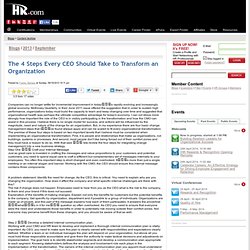
McKinsey Quarterly, in their June 2011 issue offered the suggestion that in order to sustain high performance, organizations today must build the capacity to learn and keep changing over time and suggested that organizational health was perhaps the ultimate competitive advantage for today's economy. I can not stress more strongly how important the role of the CEO is in visibly participating in the transformation and how the CMO can assist in this process.